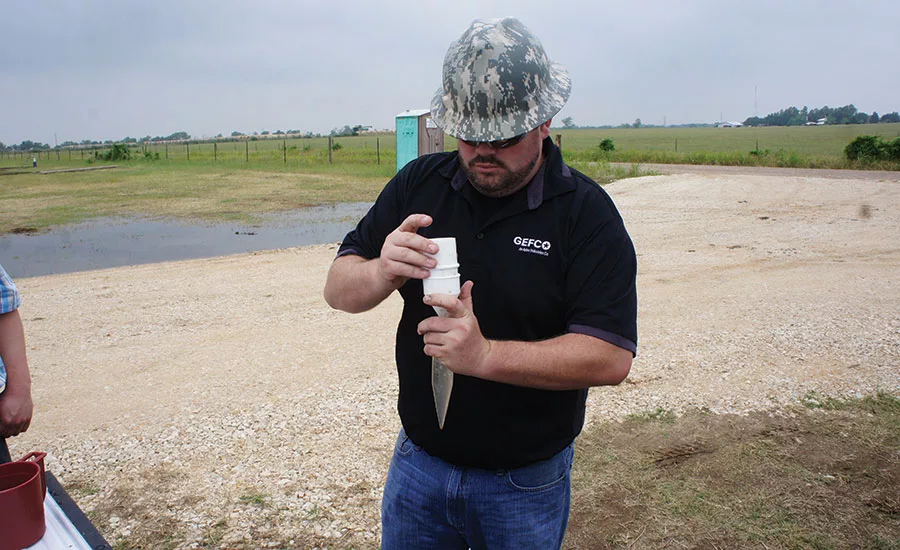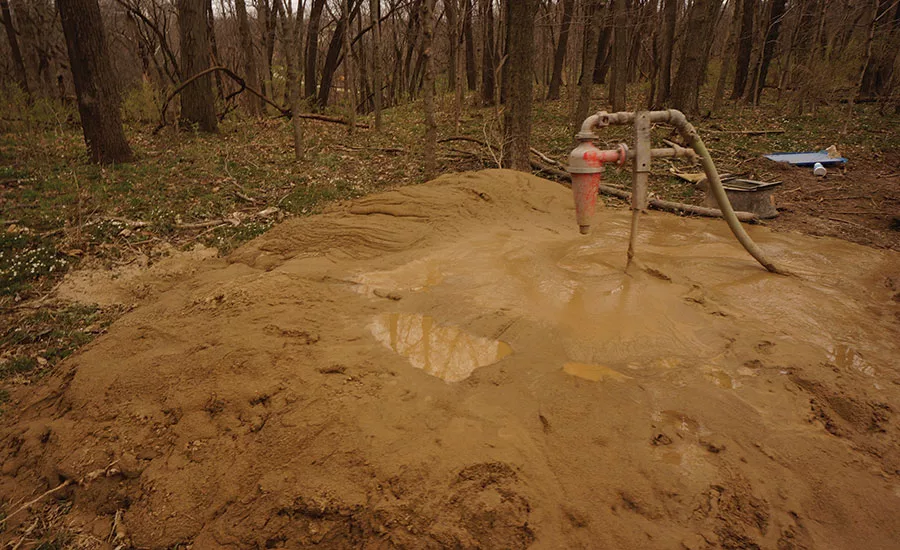On a Drilling Job, What is an Acceptable Solids Content?

Throughout the drilling phase it’s important to perform a full mud test every 30 to 45 minutes. Significant changes can help contractors make corrections.

A properly sized mechanical separation system should utilize linear high “G” shakers with the finest screens possible while still processing maximum flow rate. Source: Brock Yordy photos

If it looks like your hydrocyclone is pumping soft-serve ice cream, the cone is overworked and more cones are required. Source: Brock Yordy
Drilling is a disruptive process. Yes, I make that statement often, but it is true. As drillers and equipment operators, we have the opportunity to control the disruptive process and guarantee a successful bore. What if the damage done while finishing that bore prevents you from starting the next?
Think about how often you perform maintenance on the mud pump, fluid lines, valves and swivel. Do you keep a record? It is expected that undesirable solids will have an impact on downhole conditions and slow the drilling process. However, do you expect abrasive solids loading on that job to affect your next job? If your rig is down to replace the mud pumps every three months then yes, solids are affecting you more than just in the drilling phase.
What is an acceptable amount of solids, or percent solids content, in a drilling fluid? It depends on whom you ask in the industry. If you ask a mud engineer what an acceptable solids content is, he or she is going to say, “As low as possible, but less than 1 percent.” If you ask a mud pump engineer, they will say, “Zero. I want the fluid to be as close to water as possible.” Moreover, if you ask the rig manufacture the answer will be, “How often do you want to do maintenance?” There is not a standard answer, but more of a guideline. The more solids in a drilling fluid, the harder the pump has to work to clean the hole and the more horsepower required to pump the solids-laden fluid through the entire system. From a maintenance standpoint, the increase in horsepower is also “sand blasting” the inner workings of your fluid system.
Drilling Fluids vs. Drilling Mud
A basic sodium bentonite drilling fluid system augments water from 8.349 pounds per gallon to roughly 8.45 ppg. An API-certified sodium bentonite bag of drilling gel is permitted to have .25 percent sand content. Like drilling, mining is also a disruptive process, and a little bit of sand is unavoidable. This is why a brand new drilling fluid will produce a small amount of sand through a de-sanding cone before drilling has started. Now if you choose to use straight water and create your mud, then the sand content is unknown.
It is important to recognize the difference between an engineered drilling fluid and creating a native solids mud. An engineered drilling fluid will assist you in proper hole stability and filtration control, allowing for the least amount of undesirable solids to build up in the fluid. A native-solids mud requires borehole erosion to build a viscous fluid of native solids to carry cuttings out of the hole. Regardless of whether you choose an engineered fluid or a self-made mud, circulating solids-laden fluid through your equipment and borehole will cause damage over time. The problem is how much time do you have? The damage is not immediate, but it starts the domino effect that becomes harder to reverse. Refer to my National Driller article “What is the Life Cycle of a Drilling Fluid” (June 2015), where I mention that our goal is to create the largest cutting possible downhole, keep it intact, and removed at the surface. If the 1-inch size cutting created is turned into 100 smaller pieces, those solids become harder to remove. The higher the concentration of solids, the faster damage is done to the hole and your equipment.
Prevention Plan
The first step is to understand how quickly solids build up while drilling. Constant monitoring of the drilling fluid’s density and sand content will give you a good baseline to start your prevention plan. When I work with the United States Air Force, RED HORSE water well-drilling unit, our rule is that we want a mud density under 8.8 pounds per gallon and a sand content below 1 percent. We perform a full mud test every 30 to 45 minutes. If we see a significant change in the drilling condition or a fluid change, we immediately do another test. We have a proactive action plan to prevent solids loading.
The first and simplest action is to create a drilling fluid system that facilitates the settling of solids. We build a drilling fluid with enough suspension characteristics to help carry cuttings along with the mud pump’s uphole velocity to the surface. Once the fluid and cuttings enter the pit, the fluid’s velocity is forced to slow down, allowing the cuttings to settle out. The pit helps slow the fluid by interrupting the direction of flow and forcing the solids to fall out of suspension and land on the bottom of the pit. We design our pit or mud pan to utilize baffles, or we dig bends to slow the fluid flow to help gravity settle cuttings, rather than floating to the mud pump suction. We call this plan our passive solids control plan. In this plan, we monitor our sand content and fluid density properties at the flow line and suction line. When we get the same mud weight and sand content coming up the hole as going back down, we know we have a problem. We manipulate our surface mud by adding more baffles or increasing the size of our pit. More volume always helps with giving more time and solids loading. In the situation that a mud pan is being used with a set fluid volume, or if we cannot dig a bigger pit, we immediately move to using mechanical solids control equipment.
Mechanical Separation
Mechanical separation is required when undesirable solids break down beyond 74 microns. The simplest piece of equipment to implement is hydrocyclones. Cones are easy to setup up, but their separation process is complex. Hydrocyclones require the proper gallons per minute and psi to operate efficiently; always follow the manufacturers recommendation on gpm and psi. Improperly operated cones pump undesirable solids through the overflow and back to the mud pump suction, causing faster solids loading. A project lives and dies by the amount of fluid a single hydrocyclone can process. If the cone appears like it is pumping soft-serve ice cream, as opposed to a conical spray of solids and effluent, then the cone is overworked and more cones are required. If cones are operating properly and the solids content continues to rise, it is time to utilize a full solids control system. A properly sized system should utilize linear high “G” shakers with the finest screens possible while still processing maximum flow rate. The system will have a bank of hydrocyclones to remove undesirable solids before they become detrimental. A good solids control system can handle a wide range of solids and variable rates of drilling.
Regardless of which method you choose — a mud pit, cones or a full solids control system — the goal is to remove undesirable solids the first time they come to the surface. It is important to recognize when drill solids are having an impact on the job and preventing you from getting to the next one. The actions I outlined have helped projects from Indianapolis to Iraq. Low solids drilling systems are easy to maintain when a plan is in place, proper equipment is implemented and the solids content is constantly monitored. Take steps today to make sure that your plan is designed for the long-term life of your equipment. A local mud engineer can help you customize the right drilling fluid plan for your area and teach you how to test your drilling fluids. The best plan is to prevent undesirable solids from recirculating. Don’t let the disruptive drilling process disrupt your bottom line.
Looking for a reprint of this article?
From high-res PDFs to custom plaques, order your copy today!



